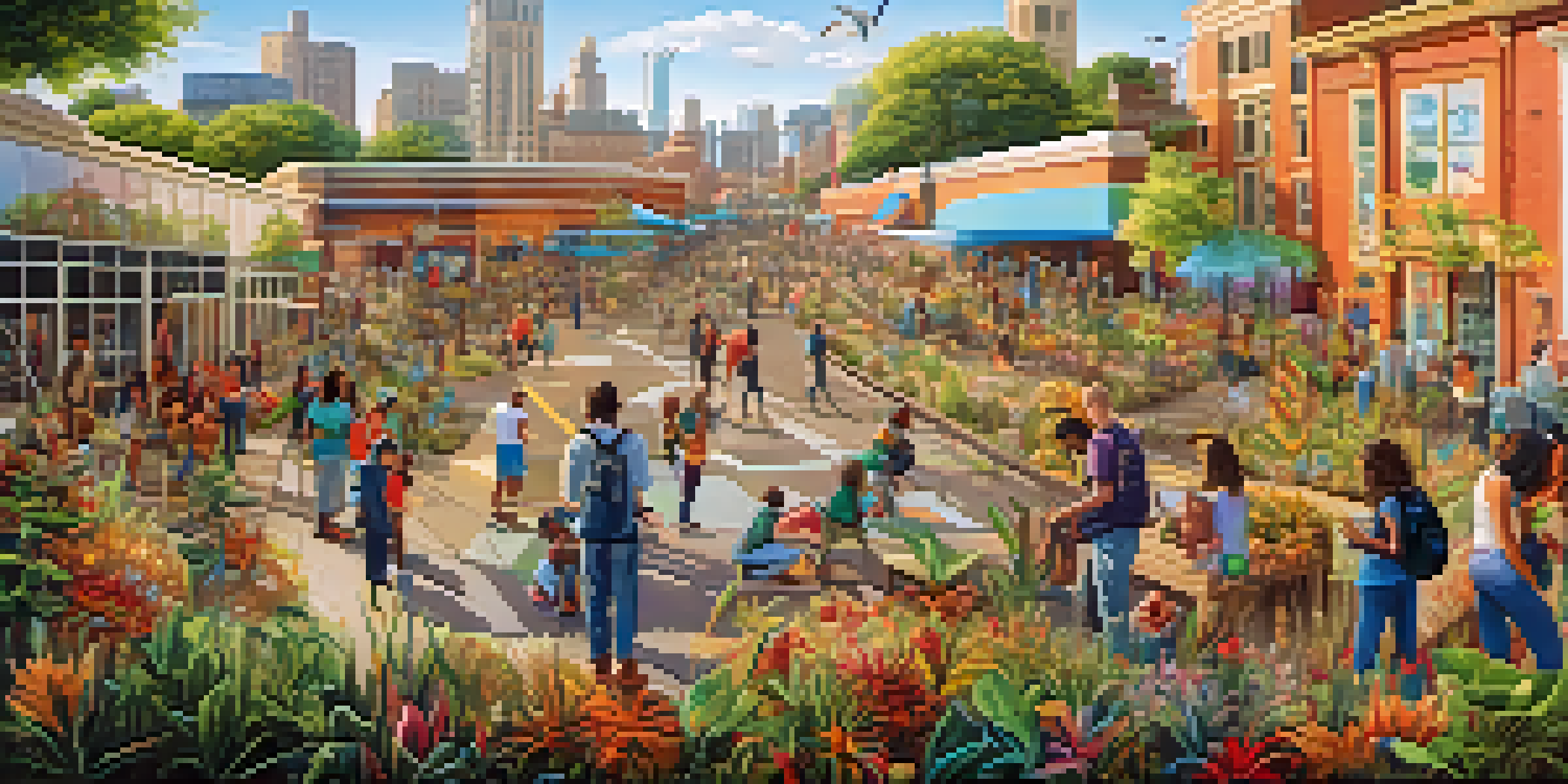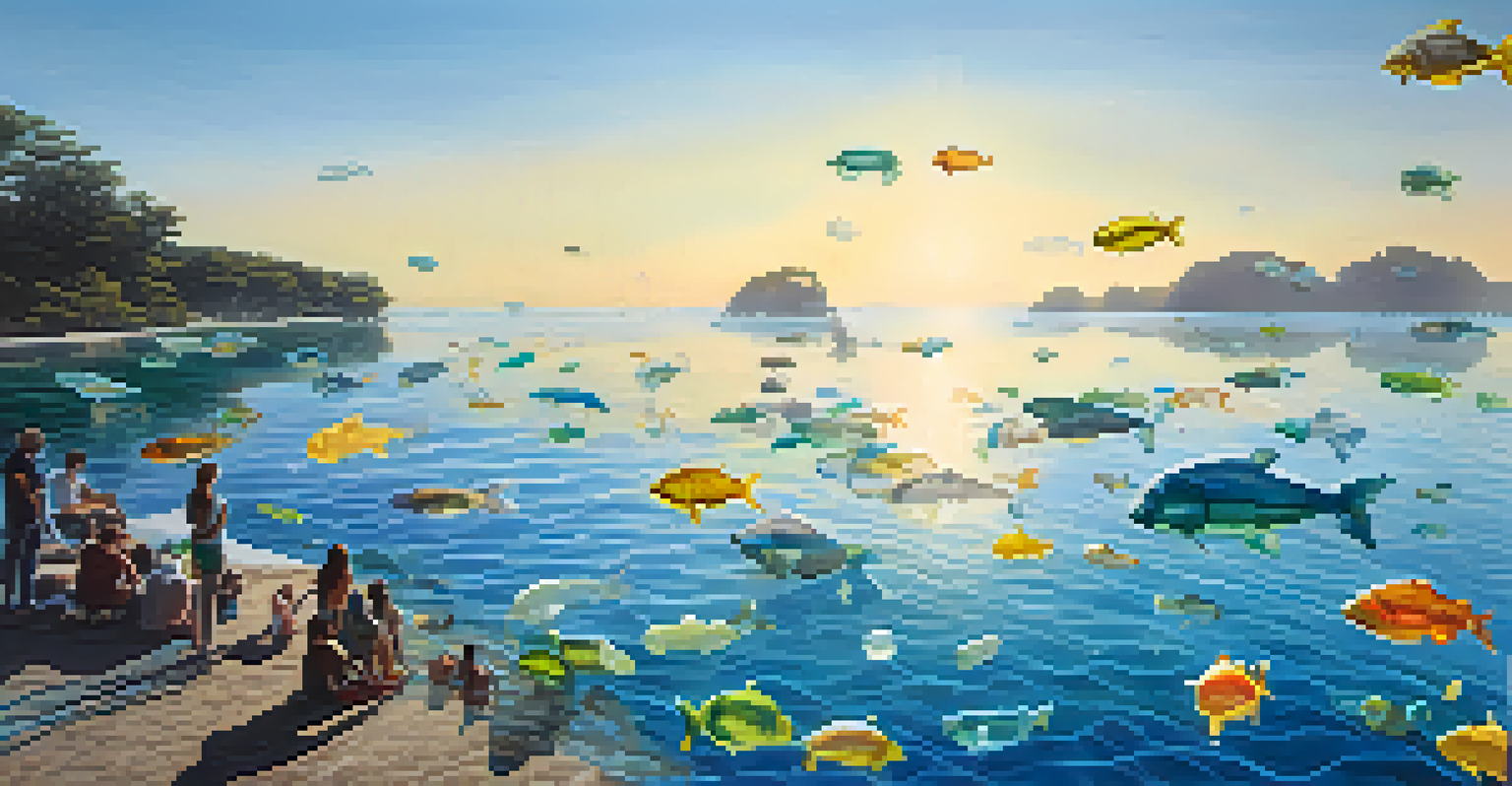Eco-Art: Blending Aesthetics with Environmental Activism

What is Eco-Art and Why Does It Matter?
Eco-art is a form of artistic expression that focuses on environmental themes, promoting awareness and action regarding ecological issues. By integrating nature and sustainable practices into their work, eco-artists aim to inspire viewers to reflect on their impact on the planet. This fusion of art and activism serves as a powerful tool for change, making complex environmental messages accessible through visual engagements.
Art is not a mirror to reflect the world, but a hammer with which to shape it.
The significance of eco-art lies in its ability to provoke thought and dialogue about pressing issues like climate change, deforestation, and pollution. Rather than simply showcasing beauty, these artists challenge us to confront the realities of environmental degradation. By doing so, they encourage a deeper connection with nature and foster a sense of responsibility towards its preservation.
In a world inundated with information, eco-art stands out by capturing attention and sparking emotions, often leading to a stronger commitment to environmental actions. It’s not just about aesthetics; it’s about instigating a movement where art becomes a catalyst for ecological mindfulness.
The History of Eco-Art: From Concept to Movement
The roots of eco-art can be traced back to the late 1960s and early 1970s, when artists began exploring themes of nature and environmentalism in their work. During this period, movements like Land Art emerged, where artists utilized natural landscapes as their canvas. This laid the groundwork for eco-art as we know it today, blending creativity with a growing awareness of ecological issues.

As environmental concerns gained prominence, so did the role of artists in advocating for change. Eco-art evolved to include not just aesthetic value but also a commitment to sustainability and activism. Artists started to use recycled materials and engage in projects that directly addressed environmental problems, transforming their work into a form of protest and education.
Eco-Art Inspires Environmental Action
Eco-art combines creativity and activism to provoke thought about ecological issues and inspire commitment to environmental stewardship.
By the 1990s and 2000s, eco-art had solidified into a recognized movement, with artists around the globe collaborating with communities to create impactful installations. This shift highlighted the importance of collective action, emphasizing that art could transcend individual expression and become a means for communal empowerment and environmental stewardship.
Media and Materials: Sustainable Practices in Eco-Art
One of the defining features of eco-art is the use of sustainable materials and practices. Artists often opt for recycled, reclaimed, or natural materials to minimize their ecological footprint. This not only reduces waste but also promotes a message of sustainability, encouraging viewers to reconsider their own consumption habits.
The best way to predict the future is to create it.
For instance, artists might use plastic waste to create stunning sculptures, transforming something discarded into a thought-provoking piece of art. This approach not only highlights the issue of pollution but also showcases the potential of reimagining waste into something beautiful and meaningful. It serves as a reminder that we have the power to change our relationship with materials through creative thinking.
Additionally, many eco-artists employ eco-friendly practices in their production processes. This includes using non-toxic paints, solar energy for installations, and even creating art that grows or changes over time, like living sculptures made from plants. Such practices underline the commitment of eco-artists to honor the environment in every aspect of their work.
The Role of Community in Eco-Art Projects
Community engagement is a cornerstone of many eco-art projects. Artists often collaborate with local residents, schools, and organizations to create works that resonate within specific environmental contexts. This participatory approach not only enriches the artwork but also empowers communities to take ownership of their environmental narratives.
For example, a community might come together to create a mural that tells the story of their local ecosystem, highlighting both its beauty and the threats it faces. This collective effort fosters a sense of pride and responsibility, making environmental activism a shared goal. It also builds relationships among participants, transforming the act of creating art into a powerful vehicle for community bonding.
Community Engagement in Eco-Art
Collaboration with local communities enriches eco-art projects, fostering a sense of ownership and collective responsibility towards environmental narratives.
Through workshops and collaborative events, eco-artists invite individuals to explore their creativity while addressing environmental issues. This hands-on involvement deepens the impact of the artwork and encourages ongoing conversations about sustainability, making eco-art a dynamic tool for community education and action.
Iconic Eco-Art Installations Around the World
Several iconic eco-art installations have garnered international attention, showcasing the potential of art to address environmental concerns. One notable example is Christo and Jeanne-Claude's 'The Gates,' which transformed Central Park in New York City with thousands of vibrant orange gates. While visually stunning, this project also sparked discussions about urban spaces and nature, illustrating the interplay between art and the environment.
Another impactful installation is 'The Ocean Cleanup' by Boyan Slat, which not only serves as a functioning tool to remove plastic from oceans but also raises awareness about marine pollution. This project exemplifies how eco-art can blend aesthetics with practical solutions, making environmental activism tangible and actionable.
These installations demonstrate that eco-art extends beyond traditional boundaries, merging creativity with science and technology. By capturing the public's imagination, these works inspire individuals to engage with environmental issues on a deeper level, proving that art can be an effective catalyst for change.
Challenges Facing Eco-Art and Its Practitioners
Despite its impact, eco-art faces several challenges, including funding and institutional support. Many eco-artists often struggle to secure grants or sponsorships, as their projects may not fit into traditional art funding categories. This financial barrier can limit their ability to create large-scale installations or reach wider audiences, hindering the growth of the movement.
Furthermore, the ephemeral nature of some eco-art projects poses another challenge. Many installations are designed to be temporary, which can make it difficult for artists to achieve lasting visibility and impact. This transience raises questions about preservation and the long-term effectiveness of these works in sparking environmental dialogue.
Future of Eco-Art Embraces Innovation
Emerging technologies and a focus on climate change position eco-art to address pressing global issues while inspiring new generations to advocate for the planet.
Lastly, eco-art must navigate the balance between activism and artistry. While the intention is to inspire change, there is a risk of diluting the message if the work is perceived as merely decorative. Striking this balance requires thoughtful consideration from artists, ensuring that their creations resonate with both aesthetic appeal and profound environmental messages.
The Future of Eco-Art: Trends and Possibilities
As we look to the future, eco-art is poised to evolve alongside emerging technologies and environmental challenges. Digital art and virtual reality are beginning to play significant roles, allowing artists to create immersive experiences that highlight environmental issues in new ways. This innovation opens doors for broader audiences to engage with eco-art, transcending geographical and cultural barriers.
Moreover, the growing focus on climate change means that eco-artists will likely continue to address urgent global issues through their work. From rising sea levels to biodiversity loss, these artists have the potential to influence public perception and policy through visual storytelling. The urgency of these challenges necessitates creative solutions that eco-art can provide.

Ultimately, the future of eco-art will likely be characterized by collaboration, innovation, and a deepening commitment to sustainability. As artists continue to push boundaries and explore new mediums, they will inspire future generations to appreciate the beauty of our planet while advocating for its protection.